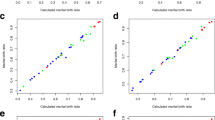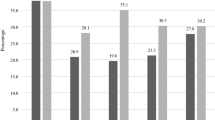Abstract
We examine recent fertility trends in Ethiopia for evidence of short- and long-term responses to famine, political events, and economic decline. We use retrospective data on children ever born from the 1990 National Family and Fertility Survey to estimate trends in annual marital conception probabilities, controlling for women’s demographic and socioeconomic characteristics. The results of our analysis provide evidence of significant short-term declines in conception probabilities during years of famine and major political and economic upheaval. In the longer term, marital fertility in both urban and rural areas declined in the 1980s after increasing moderately in the 1970s.
Similar content being viewed by others
References
Abegaz, B., ed. 1994. Essays on Ethiopian Economic Development. Aldershot, England: Avebury.
Allison, R.D. 1982. “Discrete-Time Methods for the Analysis of Event Histories.” Pp. 61–98 in Sociological Methodology, edited by S. Leindhardt. San Francisco: Jossey-Bass.
Baker, J. 1994. “Small Urban Centres and Their Role in Rural Restructuring.” Pp. 152–71 in Ethiopia in Change: Peasantry, Nationalism and Democracy, edited by A. Zegeye and S. Pausewang. London: British Academic Press.
Bariagaber, A. 1995. “Linking Political Violence and Refugee Situations in the Horn of Africa: An Empirical Approach.” International Migration Review 33:209–34.
Bongaarts, J. 1980. “Does Malnutrition Affect Fecundity? A Summary of Evidence.” Science 208(8):564–69.
Bongaarts, J. and M. Cain. 1981. “Demographic Responses to Famine.” Pp. 44–59 in Famine, edited by K.M. Cahill. New York: Orbis Books.
Cain, M. 1981. “Risk and Insurance: Perspectives on Fertility and Agrarian Change in India and Bangladesh.” Population and Development Review 7:435–74.
—. 1983. “Fertility as an Adjustment to Risk.” Population and Development Review 9:688–702.
Caldwell, J.C. and P. Caldwell. 1992. “Famine in Africa: A Global Perspective.” Pp. 367–90 in Mortality and Society in Sub-Saharan Africa, edited by É. van de Walle, G. Pison, and M. Sala-Diakandu. Oxford: Clarendon Press.
Caldwell, J.C., P.H. Reddy, and P. Caldwell. 1986. “Periodic High Risk as a Cause of Fertility Decline in a Changing Rural Environment: Survival Strategies in the 1980–1983 South Indian Drought.” Economic Development and Cultural Change 34:677–701.
Central Statistical Authority. 1991. The 1984 Population and Housing Census of Ethiopia: Analytical Report at National Level. Addis Ababa: Central Statistical Authority.
—. 1993. The 1990 National Family and Fertility Survey Report. Addis Ababa: Central Statistical Authority.
Clapham, C.S. 1988. Transformation and Continuity in Revolutionary Ethiopia. New York: Cambridge University Press.
Clay, D.C. and J.E. Vander Haar. 1993. “Patterns of Intergenerational Support and Childbearing in the Third World.” Population Studies 47:67–83.
Clay, J.W. and B.K. Holcomb. 1986. Politics and the Ethiopian Famine 1984–1985. Cultural Survival Report 20. Cambridge: Cultural Survival, Inc.
Cleland, J., N. Onuoha, and I. Timoeus. 1994. “Fertility Change in Sub-Saharan Africa: A Review of the Evidence.” Pp. 1–20 in The Onset of Fertility Transition in Sub-Saharan Africa, edited by T. Locoh and V. Hertrich. Liège: International Union for the Scientific Study of Population.
Cornia, G.A. and R. Paniccià. 1995. “The Demographic Impact of Sudden Impoverishment.” Seminar on Demography and Poverty. Liège: International Union for the Scientific Study of Population.
DeVos, S. 1985. “An Old-Age Security Incentive for Children in The Philippines and Taiwan.” Economic Development and Cultural Change 33:793–814.
Easterlin, R.A. 1965. “Long Swings in U.S. Demographic and Economic Growth: Some Findings on the Historical Pattern.” Demography 2:490–507.
Facts on File. 1995. Africa on File, Vol. 1. New York: Facts on File.
Galloway, P. 1988. “Basic Patterns in Annual Variations in Fertility, Nuptiality, Mortality and Prices in Pre-industrial Europe.” Population Studies 42:275–303.
Goody, J. 1990. “Futures of the Family in Rural Africa.” Pp. 119–44 in Rural Development and Population: Institutions and Policy, edited by G. McNicoll and M. Cain. New York: The Population Council.
Griffin, K., ed. 1992. The Economy of Ethiopia. New York: St. Martin’s Press.
Hansson, G. 1995. The Ethiopian Economy 1974–94: Ethiopia Tikdem and After. London: Routledge.
Hasen, A. and M. Strong. 1997. “Findings From the 1994 Census of Ethiopia.” Paper presented at the annual meeting of the Population Association of America, Washington, DC
Human Rights Watch. 1991. Evil Days: Thirty Years of War and Famine in Ethiopia. New York: Human Rights Watch.
Kidane, A. 1989. “Demographic Consequences of the 1984–1985 Ethiopian Famine.” Demography 26:515–22.
Kumar, G. 1987. “Ethiopian Famines 1973–1985: A Case Study.” Wider Working Papers No. 26. Helsinki: World Institute for Development Economic Research of the United Nations University.
Lapham, R.J. and W.P. Mauldin. 1985. “Contraceptive Prevalence: The Influence of Organized Family Planning Programs.” Studies in Family Planning 16:117–37.
Lee, R. 1990. “The Demographic Response to Economic Crisis in Historical and Contemporary Populations.” Population Bulletin of the United Nations 29:1–15.
Locoh, T. 1994. “Will the Decline in Fertility in Sub-Saharan Africa Last? A Time of Uncertainty.” Pp. 105–33 in The Onset of Fertility Transition in Sub-Saharan Africa, edited by T. Locoh and V. Hertrich. Liège: International Union for the Scientific Study of Population.
Mauldin, W.P. and J.A. Ross. 1991. “Family Planning Programs: Efforts and Results, 1982–89.” Studies in Family Planning 22:350–67.
—. 1994. “Prospects and Programs for Fertility Reduction, 1990–2015.” Studies in Family Planning 25:77–95.
Menken, J., J. Trussell, and S. Watkins. 1981. “The Nutrition Fertility Link: An Evaluation of the Evidence.” Journal of Interdisciplinary History XI:425–41.
National Research Council. 1993. Demographic Effects of Economic Reversals in Sub-Saharan Africa. Washington, DC: National Academy Press.
Niggli, P. 1986. Doubtful Methods in the Struggle Against Famine—Ethiopia: Deportations and Forced-Labour Camps. Berlin: Berliner Missionswerk.
Nugent, J.B. 1985. “The Old-Age Security Motive for Fertility.” Population and Development Review 11(1):75–97.
Palloni, A., K. Hill, and G.P. Aguirre. 1996. “Economic Swings and Demographic Changes in the History of Latin America.” Population Studies 50:105–32.
Rahmato, D. 1994. “Neither Feast nor Famine: Prospects for Food Security.” Pp. 192–208 in Ethiopia in Change: Peasantry, Nationalism and Democracy, edited by A. Zegeye and S. Pausewang. London: British Academic Press.
Rindfuss, R.R., J.S. Reed, and C. St. John. 1978. “A Fertility Reaction to a Historical Event: Southern White Birthrates and the 1954 Desegregation Ruling.” Science 201(14):178–80.
Schultz, T.P. 1993. “Returns to Women’s Education.” Pp. 59–99 in Women’s Education in Developing Countries: Barriers, Benefits, and Policies, edited by E.M. King and M.A. Hill. Baltimore: Johns Hopkins University Press.
Simpson, J.L. and S. Carson. 1993. “Biological Causes of Fetal Loss.” Pp. 287–315 in Biomedical and Demographic Determinants of Reproduction, edited by R. Gray, H. Leridon, and A. Spira. Oxford: Clarendon Press.
Thomas, N. 1991. “Land, Fertility, and the Population Establishment.” Population Studies 45:379–97.
Tiruneh, A. 1993. The Ethiopian Revolution 1974–1987: A Transformation From an Aristocratic to a Totalitarian Autocracy. Cambridge: Cambridge University Press.
United Nations. 1994. Demographic Yearbook. New York: United Nations.
Webb, P. and J. von Braun. 1994. Famine and Food Security in Ethiopia: Lessons for Africa. Chichester, U.K.: John Wiley & Sons, Ltd.
Weeks, J. 1988. “Economic Crisis and Household Survival Strategies in Sub-Saharan Africa.” Pp. 21–45 in African Population Conference, Dakar, 1988. Liège: International Union for the Scientific Study of Population.
Wood, J.W. 1994. Dynamics of Human Reproduction: Biology, Biometry, Demography. New York: Aldine de Gruyter.
World Bank. 1992. World Tables 1992. Baltimore: The Johns Hopkins University Press.
Yamaguchi, K. 1991. Event History Analysis. Newbury Park: Sage Publications.
Young, J. 1997. Peasant Revolution in Ethiopia: The Tigray People’s Liberation Front, 1975–1991. Cambridge: Cambridge University Press.
Author information
Authors and Affiliations
Corresponding author
Additional information
We would like to thank the Central Statistical Authority of Ethiopia for providing the data used in this paper. We also would like to thank Dennis Hogan, the editors of Demography, and anonymous reviewers for their helpful comments. A previous version of this paper was presented at the 1997 annual meeting of the Population Association of America, Washington, DC.
Rights and permissions
About this article
Cite this article
Lindstrom, D.P., Berhanu, B. The impact of war, famine, and economic decline on marital fertility in ethiopia. Demography 36, 247–261 (1999). https://doi.org/10.2307/2648112
Issue Date:
DOI: https://doi.org/10.2307/2648112




